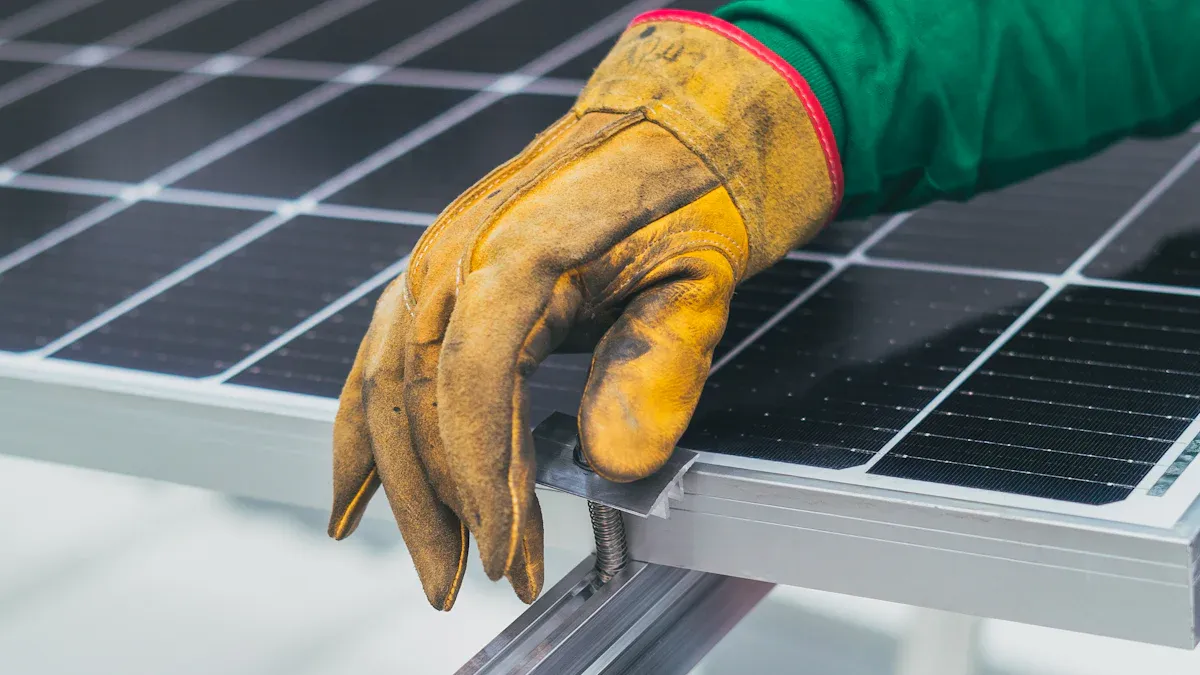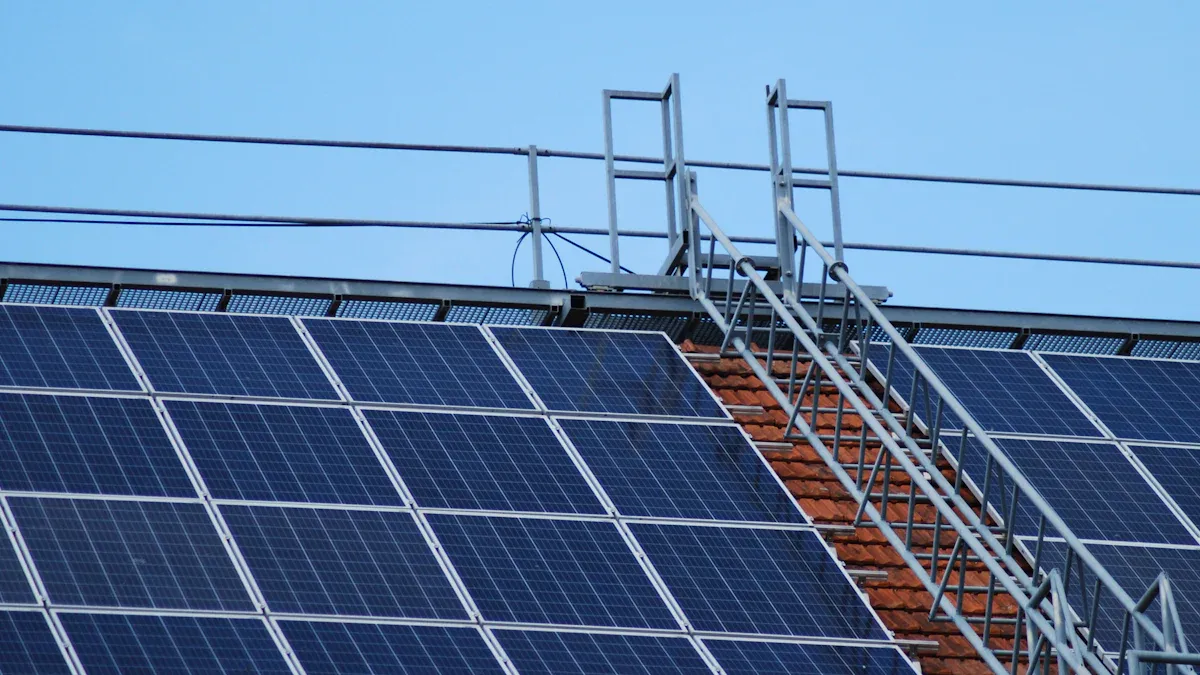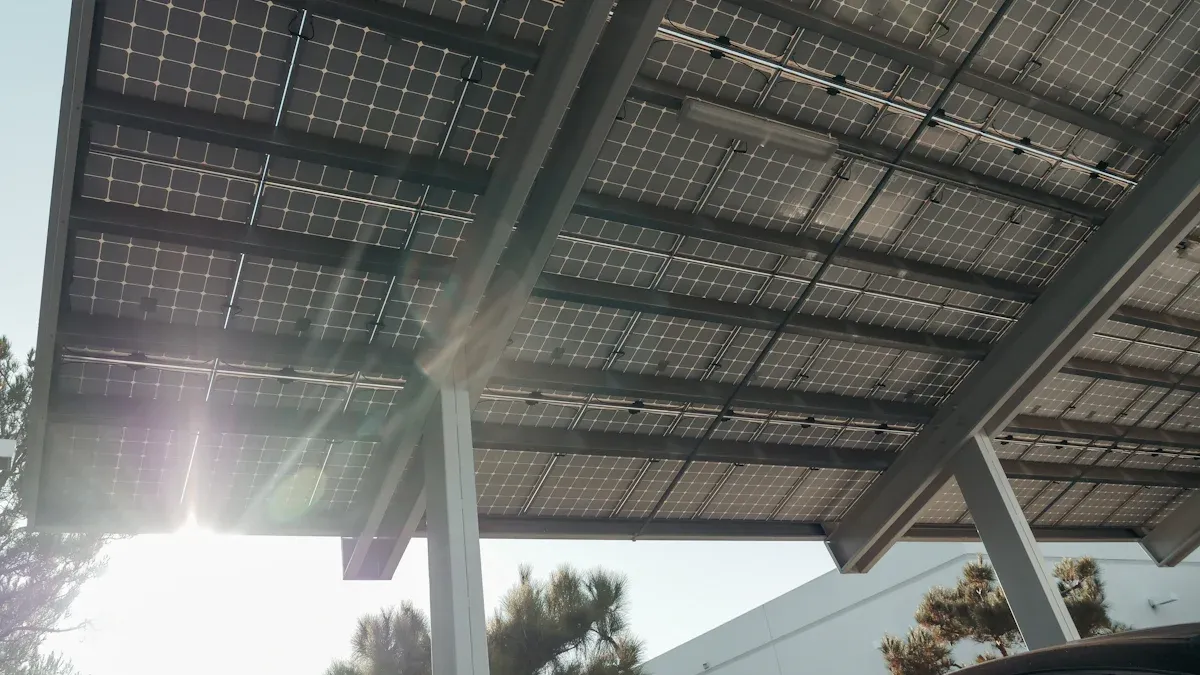5 Essential Facts About Steel Structure for PV Panel Evolution

Steel Structure for PV Panel technology now shapes the backbone of modern solar projects, offering enhanced strength and flexibility.
Recent data show North America holds over 40% of the global market, with Asia Pacific and Europe following closely.
Engineers now use advanced steel processing and recycled materials, meeting sustainability goals and supporting smart, adaptive solar systems.
As demand rises, these innovations influence both the efficiency and future direction of solar energy worldwide.
Key Takeaways
Steel structures now do more than support solar panels; they improve system strength, cooling, and maintenance.
Advanced steel materials and coatings make solar frames lighter, stronger, and more resistant to rust and weather.
Well-designed steel frames help solar panels produce more energy by reducing shading and adapting to different layouts.
Using recycled and low-carbon steel lowers environmental impact and supports long-lasting, sustainable solar projects.
Smart steel structures with sensors and tracking systems boost energy efficiency and prepare solar systems for the future.
1. System Integration
From Support to Core
Steel Structure for PV Panel systems have changed a lot over the past decade. In the early days, these structures only served as basic supports for solar panels. Today, they play a much bigger role. Engineers now design steel frames to handle more than just weight. These structures must resist wind, snow, and even earthquakes. They also help with cooling and cable management. Some new designs allow for easy upgrades or repairs, making them a core part of the solar system.
Tip: Choosing the right Steel Structure for PV Panel can increase the lifespan and efficiency of a solar project.
Modern steel frames often use cold-formed steel. This type of steel allows for faster construction and lower maintenance costs. It also helps projects start producing energy sooner. Many companies now use advanced coatings to protect steel from rust and weather damage. These improvements make steel frames more reliable and adaptable.
Role in PV Systems
Steel Structure for PV Panel solutions now serve as the backbone of solar installations. They support the panels, but they also connect with other system parts. For example, some frames include mounts for inverters or battery storage. Others have built-in channels for wiring, which keeps the system safe and tidy.
Mechanical performance matters a lot in these systems. The table below shows the main factors that affect how well a steel structure works in a PV system:
Factor Category | Specific Considerations |
|---|---|
Material Quality | Steel type, grade, tensile and yield strength, toughness, corrosion resistance |
Load and Design | Dead, live, wind, snow, seismic loads; connection details; reinforcement |
Corrosion Resistance | Protective coatings, galvanization, environmental exposure |
Mounting Methods | Ballasted, ground-mounted, roof-mounted, innovations in mounting techniques |
Compliance | Adherence to updated standards and safety codes |
Cost vs. Long-Term Value | Initial construction costs, maintenance costs, insurance costs, ROI, life cycle cost analysis |
These factors help ensure that each Steel Structure for PV Panel delivers strength, safety, and long-term value. As solar technology grows, the role of steel structures will keep expanding.
2. Material Advances

Steel Structure for PV Panel
Recent years have brought remarkable changes to the materials used in Steel Structure for PV Panel systems. Engineers now select advanced steel alloys and coatings to meet the demands of modern solar installations. High-strength, low-weight steels such as martensitic and TRIP steels allow for lighter yet stronger frames. These materials help reduce the overall weight of solar arrays while maintaining excellent load-bearing capacity. Stainless steel grades like 304 and 316 have become popular for their natural corrosion resistance and long service life. Their chromium content forms a protective oxide layer, which means less need for extra coatings.
Innovative coatings also play a key role. Nanotechnological coatings create nearly impermeable barriers against corrosive agents. Magnesium-Aluminum-Zinc (MAC) and Aluminum-Magnesium-Zinc (AMZ) alloy coatings offer self-repairing properties. When scratches or cuts occur, these coatings form new protective films, keeping the steel safe from rust. These advances lower maintenance costs and extend the lifespan of Steel Structure for PV Panel installations.
Note: AMZ-coated steel can last over 30 years without red rust under normal conditions, making it a smart choice for long-term solar projects.
Durability and Design
Material advances have improved both the durability and design flexibility of Steel Structure for PV Panel systems. The following table highlights common steel alloys and their benefits:
Steel Alloy Type | Use in PV Structures | Key Benefits | Corrosion Resistance Treatment |
|---|---|---|---|
Q235B Steel | Large/heavy arrays, strong wind areas | High strength, durability, excellent load capacity | Hot-dip galvanization (55-80 μm or higher) |
Stainless Steel (304 & 316) | Solar racks and supports | Superior strength, excellent corrosion resistance | Inherent chromium oxide layer, no extra coating |
Engineers also use advanced thermal spray coatings, such as CoNiCrAlY, to protect steel from high-temperature corrosion. These coatings form dense oxide layers that block moisture and chemicals. Selective solar absorber coatings and anti-reflection layers further boost efficiency by improving heat retention and reducing energy loss.
Recent design innovations include:
Lightweight, modular frames for faster installation
Eco-friendly coatings that reduce environmental impact
Increased use of recycled materials in steel production
These improvements make Steel Structure for PV Panel systems more compatible with evolving solar technology. They also help solar projects last longer and perform better in harsh environments.
3. Efficiency and Reliability
Energy Yield
Steel structure design plays a major role in the energy yield of photovoltaic systems. Engineers now use steel substrates for thin-film PV modules, which allow for flexible placement and better integration into buildings. These thin-film modules on steel perform well in less-than-ideal conditions, such as vertical or north-facing facades, where traditional crystalline silicon panels often lose efficiency.
Thin-film PV on steel maintains higher energy yields in high temperatures and low ventilation, avoiding the performance drops seen in other modules.
Flexible steel structures support creative layouts, like East-West splits or evenly spaced modules, which can boost both peak and annual energy generation.
Integration of PV into steel building elements helps offset material and installation costs, supporting zero energy building goals.
Advances in manufacturing, such as Roll to Roll (R2R) processes, reduce waste and lower costs, making energy systems more viable.
Environmental and operational factors also affect energy yield. Wind can cool PV modules, increasing output by over 14%. However, snow accumulation may cause up to 12% annual energy loss. Shading remains a critical issue. Even partial shading of one cell can reduce the entire module’s output by 25%, and full shading can cause a 75% power loss. Steel support structures must minimize shading and allow for easy cleaning to reduce soiling from dust or pollen.
Tip: Proper design and placement of steel structures can help avoid shading and maximize sunlight exposure, leading to higher energy yields.
System Uptime
Reliability depends on both the strength and adaptability of steel structures. Modern innovations ensure that steel frames withstand harsh weather, reducing the need for repairs and keeping systems running longer.
High durability and corrosion resistance allow steel structures to perform well in extreme conditions.
Pre-engineered modular components speed up installation and lower labor costs, minimizing downtime.
Adjustable mounts and integrated tracking systems help optimize panel orientation, improving energy capture.
Access platforms built into steel infrastructure make maintenance safer and faster, reducing the risk of unexpected outages.
Regular inspections and maintenance, supported by robust steel designs, extend system lifespan and prevent long-term failures.
Steel structures also adapt to diverse terrains and climates, ensuring seamless integration and fewer installation delays. Their recyclable nature supports both reliability and sustainability, making them a smart choice for long-term solar projects.
4. Sustainability

Net-Zero Steel
Steel production stands as one of the most energy-intensive industries worldwide. Many steel plants now look to solar photovoltaic (PV) systems to cut electricity costs and reduce carbon emissions. For example, China’s steel industry produced 873 million tons of crude steel in 2021, releasing about 1.6 billion tons of CO2. If steel plants switched to 100% PV-powered electricity, they could cut annual CO2 emissions by up to 310 million tons. East coastal plants show the most promise for this transition. Even with cost-saving measures, emission reductions of 32–64 million tons per year remain possible.
Global roadmaps aim for near-zero emissions in steel by 2050. However, challenges like limited recycled scrap, high-grade iron ore shortages, and technology investment risks may leave a 10% gap in reaching these targets. Despite these hurdles, new steelmaking methods—such as hydrogen-based processes and electric arc furnaces—help lower the carbon footprint. These innovations support the solar sector’s push for cleaner, more sustainable infrastructure.
Note: Using recycled steel and low-carbon electricity in PV panel structures can reduce greenhouse gas emissions by up to 50% compared to traditional coal-based steel.
A comparison of frame materials highlights the environmental benefit:
Material Type | CO2 Emissions per 1 MW Output | GHG Impact Reduction vs. Aluminum |
|---|---|---|
Aluminum Frames | 217 tons CO2 | Baseline |
Recycled Steel | 15 tons CO2 | ~90% less |
Lifecycle Value
Steel structures offer strong lifecycle value for PV systems. Their recyclability and durability make them a top choice for sustainable solar projects.
Steel emits about 1.1 kg CO2-eq per kg, four times less than aluminum.
Manufacturing steel uses 18.2 MJ/kg, much less than aluminum’s 178 MJ/kg.
Steel supports can account for over 45% of a PV plant’s total CO2 emissions.
Recycling steel reduces environmental impacts by 25%, cutting total carbon emissions by up to 38%.
End-of-life recycling of steel lowers fossil resource use by 12–24% and total energy consumption by about 18%.
Steel’s strength, corrosion resistance, and recyclability ensure long-term efficiency and low maintenance. These qualities help solar projects meet global sustainability goals, such as SDG 7 (Affordable and Clean Energy) and SDG 13 (Climate Action). By choosing steel, solar developers support a cleaner, more resilient energy future.
5. Smart and Future Trends
Digital Integration
Smart technologies now shape the future of solar energy systems. Engineers equip steel structures with real-time monitoring systems that track structural health. These systems detect stress points and alignment shifts early, which helps reduce repair costs and extend the lifespan of installations. Smart solar tracking systems adjust panel angles throughout the day, maximizing sunlight exposure even when clouds or wind conditions change. Steel structures provide the strength and resilience needed to support these moving parts.
Many solar projects now connect to mobile apps. Users can monitor electricity usage, battery charge levels, and energy flow from their phones. Advanced battery storage systems, such as lithium-ion and lithium iron phosphate batteries, store extra solar energy for use during low sunlight or peak demand. Grid compliance features ensure safe integration with power infrastructure, including voltage regulation and frequency control. These digital tools improve energy efficiency, reliability, and transparency.
Smart integration lowers the levelized cost of energy and increases long-term savings by automating adjustments based on terrain and weather.
Adaptive Structures
Adaptive steel structures represent a major leap forward in photovoltaic technology. These systems use sensors, actuators, and control mechanisms to adjust orientation and material properties in real time. For example, adaptive Building Integrated Photovoltaic (BIPV) shading systems balance solar irradiance, internal illuminance, and thermal comfort. Multi-objective computation methods help maximize energy generation while maintaining comfortable lighting levels inside buildings.
Engineers design adaptive structures to withstand harsh environments. In coastal areas, they use marine-grade stainless steel and reinforced mounting techniques to resist high winds, salt spray, and flooding. Features like deep anchors, aerodynamic racking, and weather sealing ensure durability. Adaptive systems can also be retrofitted to existing buildings, allowing users to select preferred lighting levels and improve comfort.
Key trends for Steel Structure for PV Panel systems include:
Modular and customizable designs for different climates
Use of eco-friendly steel and recycling practices
Engineering for hurricane-grade wind resistance
Integration with energy storage and electric vehicle charging
These innovations make steel structures future-ready, supporting flexible and sustainable solar infrastructure.
Steel structures for PV panels continue to evolve, shaping the future of solar energy. Key trends include:
Recycled steel and low-carbon materials lower embodied carbon emissions.
Modular construction methods improve efficiency and reduce waste.
Smart integration, such as BIPVs and automation, optimizes energy use.
These advances support sustainable, efficient, and intelligent solar systems. Ongoing innovation in steel structures will help meet net-zero goals and create smarter, greener energy solutions for tomorrow.
FAQ
What makes steel a good choice for PV panel structures?
Steel offers high strength, durability, and resistance to harsh weather. Engineers can shape steel into many forms, making it adaptable for different solar projects. Recycled steel also supports sustainability goals.
How does steel compare to aluminum for solar frames?
Feature | Steel | Aluminum |
|---|---|---|
Strength | Higher | Lower |
Cost | Lower | Higher |
Sustainability | More recyclable | Less recyclable |
Steel provides better strength and lower cost than aluminum.
Can steel structures support smart solar technologies?
Yes! Steel frames now include mounts for sensors, trackers, and battery systems. These features help solar panels adjust to sunlight and improve energy output.
Are steel PV structures environmentally friendly?
Steel structures use recycled materials and require less energy to produce than aluminum. Their long lifespan and recyclability reduce waste and support green energy goals.
See Also
Essential Structural Design Aspects of ESTEL Outdoor Telecom Cabinets
A Comprehensive Look at ESTEL Outdoor Telecom Cabinet Structures
Latest Developments Shaping Outdoor Telecommunication Cabinets Today
Solar Energy Storage Solutions for Telecom Cabinet Power Systems
Insights Into Outdoor Communication Cabinet Designs for 2025
CALL US DIRECTLY
86-13752765943
3A-8, SHUIWAN 1979 SQUARE (PHASE II), NO.111, TAIZI ROAD,SHUIWAN COMMUNITY, ZHAOSHANG STREET, NANSHAN DISTRICT, SHENZHEN, GUANGDONG, CHINA


